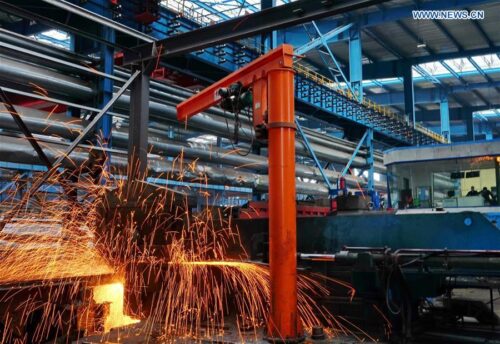>>REAL-TIME UPDATES IN THE WIRE. CLICK HERE<<<
An increasing number of Chinese steelmakers are making losses amid sluggish market demand falling prices. Among China’s 247 major steelmakers, only 15.15% of them were making profits in late June, compared to 83.55% in March, plunging by 70 percentage points in three months, according to data compiled by consultancy Mysteel.
In the first half of 2022, China’s domestic crude steel demand declined at a faster pace than the drop in supply, it said.
China’s crude steel output fell 8% year over year in the first half of 2022 to 509 million tonnes, while crude steel consumption fell by 9% to 472 million tonnes, leaving an oversupply in the market, according to Mysteel.
The steel sector’s production is facing great challenges, said the China Iron and Steel Association (CISA) at a forum about sliding steel supply, weak demand, falling prices and worsening profits, etc on July 8.
Executives of several steel companies have issued warnings over the gloomy market situation.
“June and July is the most difficult period for sector. New orders and prices of steel products are under pressure,” said Wang Juan, Chief Financial Officer of China’s Baoshan Iron & Steel Co Ltd.
In June and July, many companies gradually resumed production, but they faced high inventories and their operating rate was only around 85%, with recovery of steel orders weaker than expected, said Wang.
“Anyang Iron & Steel Co., Ltd was very difficult in the first half of the year,” Li Lijian, chairman of the company on June 30. “The sector was experiencing wide-spread losses and the losses were still expanding.”
In addition, “the traditional light season for steel demand comes with high temperature and rainy weather in July and August, the situation is very challenging”, he said.
“We should be prepared for a long period of fierce competition,” said Liu Jianrong, chairman of Xinyu Iron & Steel Co., Ltd, said on July 1. “The sector’s profitability has weakened further and a new round of fierce competition has come.”
Since June, steel prices in China have declined significantly. On July 8, the most-traded steel rebar futures contract on the Shanghai Futures Exchange, for September delivery, hit 4,196 yuan per tonne, falling by 12.5% from the same period in the prior month and sliding by about 22% from the same period last year.
The most active hot-rolled coil futures contract hit 4,206 yuan per tonne, falling about 14% from a month earlier and sliding by about 27% from the same period last year.
While steel prices are falling, the cost for steel production remains high. The most-traded iron ore futures contract on the Dalian Commodity Exchange, for September delivery hit 755.5 yuan per tonne, slumping 36% from a year earlier. But the most active contract of coke and coking coal contracts were 2,206 yuan per tonne and 2,936 yuan per tonne, respectively, rising 21% and 19% year over year.
According to Mysteel, average losses on steel rebar production stood at 317 yuan per tonne at the end of June, while average losses on production of hog-rolled coil was 261 yuan per tonne.
More and more steelmakers are reducing or suspending production to reduce losses. Mysteel data showed that, at China’s 247 major steel mills, operating rate of blast furnace was 78.53% last week, falling by 2.26% from the previous week and down 6.85% from the same period last year.
Utilization rate of blast furnace capacity stood at 85.71%, down 1.9% from the week before, though up slightly by 0.23% from a year ago, showed the data.
China’s steel inventories remain elevated. In late June, major steel makers’ steel inventories stood at 16.95 million tonnes, rising by 23% from a year earlier, and jumping by 50% from the start of the year.
Production cut in the sector has failed to boost steel prices. He Wenbo, party chief of the CISA said last week that the main problem for the steel market was on the demand side, though the solution was in the supply side, suggesting the sector needs to continue to cut production.
He said that steel production in the recent two months was significantly higher than market demand and the most important task at the moment is for the sector to strengthen self-discipline.

